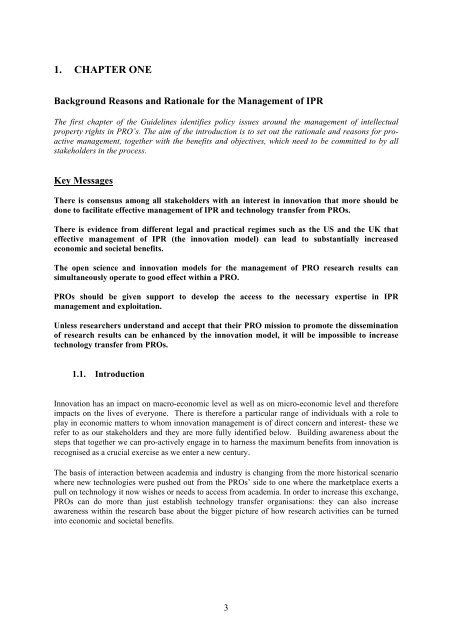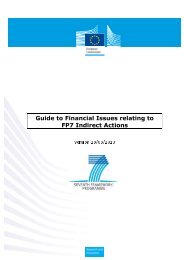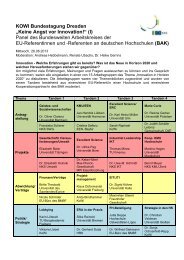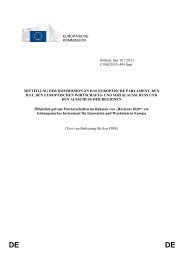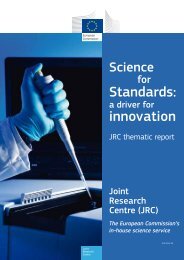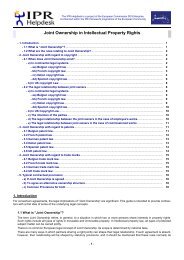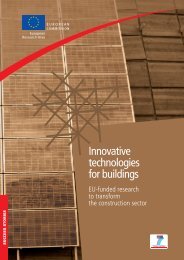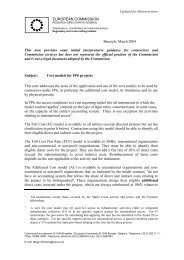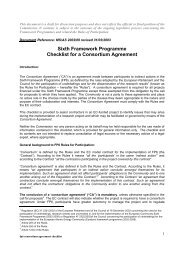Expert Group Report Management of Intellectual Property in ... - KoWi
Expert Group Report Management of Intellectual Property in ... - KoWi
Expert Group Report Management of Intellectual Property in ... - KoWi
Create successful ePaper yourself
Turn your PDF publications into a flip-book with our unique Google optimized e-Paper software.
1. CHAPTER ONE<br />
Background Reasons and Rationale for the <strong>Management</strong> <strong>of</strong> IPR<br />
The first chapter <strong>of</strong> the Guidel<strong>in</strong>es identifies policy issues around the management <strong>of</strong> <strong>in</strong>tellectual<br />
property rights <strong>in</strong> PRO’s. The aim <strong>of</strong> the <strong>in</strong>troduction is to set out the rationale and reasons for proactive<br />
management, together with the benefits and objectives, which need to be committed to by all<br />
stakeholders <strong>in</strong> the process.<br />
Key Messages<br />
There is consensus among all stakeholders with an <strong>in</strong>terest <strong>in</strong> <strong>in</strong>novation that more should be<br />
done to facilitate effective management <strong>of</strong> IPR and technology transfer from PROs.<br />
There is evidence from different legal and practical regimes such as the US and the UK that<br />
effective management <strong>of</strong> IPR (the <strong>in</strong>novation model) can lead to substantially <strong>in</strong>creased<br />
economic and societal benefits.<br />
The open science and <strong>in</strong>novation models for the management <strong>of</strong> PRO research results can<br />
simultaneously operate to good effect with<strong>in</strong> a PRO.<br />
PROs should be given support to develop the access to the necessary expertise <strong>in</strong> IPR<br />
management and exploitation.<br />
Unless researchers understand and accept that their PRO mission to promote the dissem<strong>in</strong>ation<br />
<strong>of</strong> research results can be enhanced by the <strong>in</strong>novation model, it will be impossible to <strong>in</strong>crease<br />
technology transfer from PROs.<br />
1.1. Introduction<br />
Innovation has an impact on macro-economic level as well as on micro-economic level and therefore<br />
impacts on the lives <strong>of</strong> everyone. There is therefore a particular range <strong>of</strong> <strong>in</strong>dividuals with a role to<br />
play <strong>in</strong> economic matters to whom <strong>in</strong>novation management is <strong>of</strong> direct concern and <strong>in</strong>terest- these we<br />
refer to as our stakeholders and they are more fully identified below. Build<strong>in</strong>g awareness about the<br />
steps that together we can pro-actively engage <strong>in</strong> to harness the maximum benefits from <strong>in</strong>novation is<br />
recognised as a crucial exercise as we enter a new century.<br />
The basis <strong>of</strong> <strong>in</strong>teraction between academia and <strong>in</strong>dustry is chang<strong>in</strong>g from the more historical scenario<br />
where new technologies were pushed out from the PROs’ side to one where the marketplace exerts a<br />
pull on technology it now wishes or needs to access from academia. In order to <strong>in</strong>crease this exchange,<br />
PROs can do more than just establish technology transfer organisations: they can also <strong>in</strong>crease<br />
awareness with<strong>in</strong> the research base about the bigger picture <strong>of</strong> how research activities can be turned<br />
<strong>in</strong>to economic and societal benefits.<br />
3


